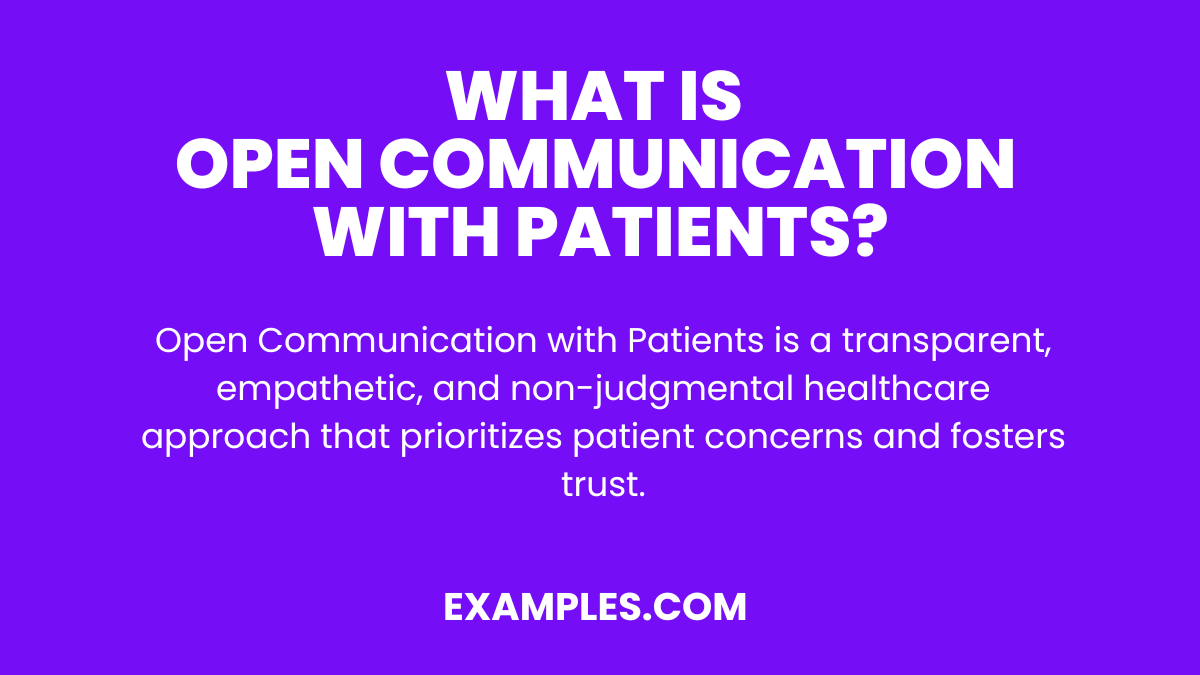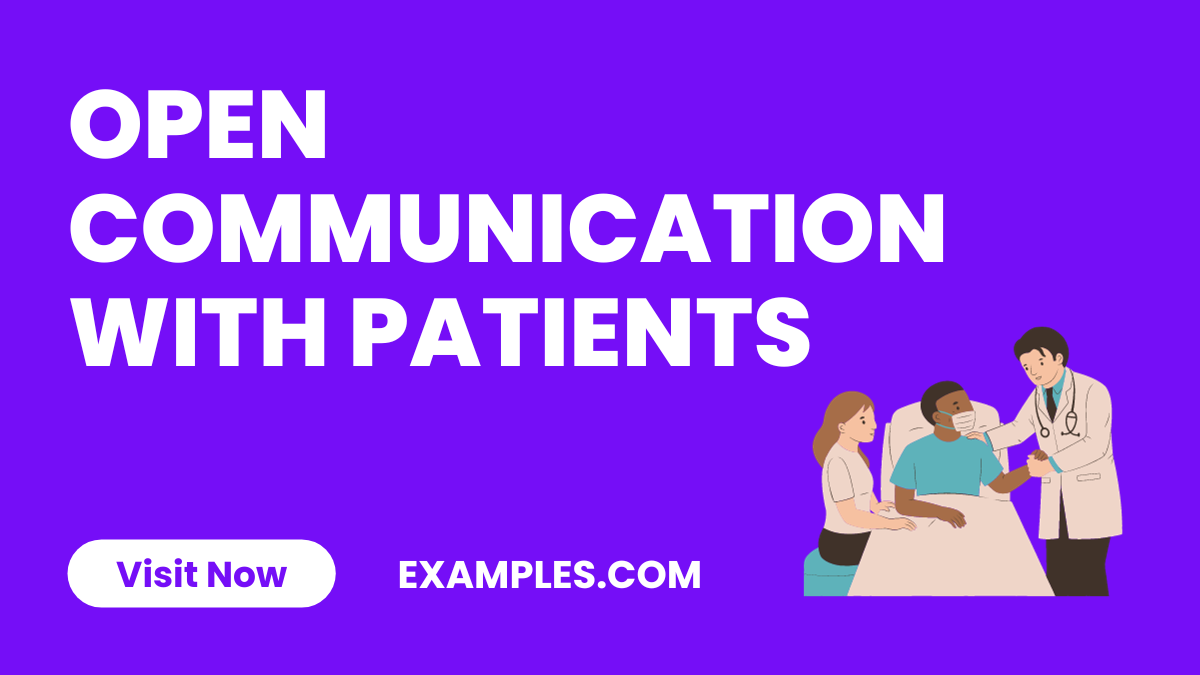5 Open Communication with Patients Examples
Embark on a journey through the realm of healthcare dialogue with our comprehensive guide on Open Communication with Patients. Discover the essence of fostering transparent and honest medical conversations, enriched with real-world Communication Examples. Gain insights on improving patient engagement, building trust, and ensuring effective healthcare outcomes. Dive deep into the strategies that empower both patients and healthcare providers with clear, compassionate, and collaborative communication.
Download Effective Open Communication with Patients PDF
What is Open Communication with Patients? – Meaning

Open Communication with patients signifies a healthcare approach where dialogue is transparent, two-way, and non-judgmental. It involves actively listening, empathizing, and responding to patient concerns, ensuring they feel heard and respected. This communication style is critical in healthcare settings, as it builds trust, fosters understanding, and leads to more accurate diagnoses and personalized care. It’s about creating a safe space where patients can freely express their thoughts and feelings, contributing to their overall well-being and treatment success.
Open Communication with Patients for Mental Health
Exploring the nexus between mental health and Open Communication in Healthcare reveals how crucial clear, empathetic exchanges are. This approach is pivotal for diagnosing and treating mental health conditions effectively. By prioritizing Open Communication Benefits, healthcare providers can better understand patient experiences, making them feel validated and supported. Understanding the Importance of Open Communication in Relationships within the medical context enhances trust and fosters a therapeutic alliance, vital in mental health care.
- “I feel overwhelmed and don’t know where to start.” – When a patient expresses this, respond with, “Let’s take it one step at a time together. Can you tell me what’s been on your mind the most lately?” This approach epitomizes Open Communication in Relationship, allowing patients to navigate their thoughts without feeling rushed.
- “I’m not sure if my feelings are normal.” – A reassuring response could be, “It’s okay to feel this way, and I’m here to listen. What you’re feeling is valid, and together we can understand it better.” This response leverages the Importance of Open Communication, validating the patient’s feelings and encouraging them to share more.
- “I’m afraid of being judged for my thoughts.” – Addressing this concern, you might say, “This is a safe space, and I’m here to help, not judge. Your thoughts are important for us to understand what you’re going through.” This exemplifies Open Communication in Healthcare, creating a non-judgmental environment.
- “I find it hard to talk about my past experiences.” – A supportive response would be, “It’s perfectly okay to take your time. When you feel ready, I’m here to listen and help you through it.” This demonstrates understanding the Importance of Open Communication in Relationships, showing patience and readiness to listen.
- “I don’t want my family to worry about me.” – In this case, say, “Your privacy is important, and we can discuss how to handle this together. Let’s explore what makes you comfortable while ensuring you get the support you need.” This strategy highlights Open Communication Benefits, balancing patient confidentiality with the need for support.
What is the Importance of Open Communication with Patients?
Understanding the Importance of Open Communication with Patients is crucial in healthcare. It forms the bedrock of patient trust and engagement, leading to more informed and participative care. Why is Open Communication Important in Workplace resonates similarly in healthcare settings, emphasizing the need for clear, honest, and supportive dialogue between providers and patients.
- Enhances Patient Trust: By practicing Honest Communication, patients feel more comfortable and are likely to share vital information about their health, leading to a more comprehensive understanding of their condition.
- Improves Patient Compliance: Clear instructions and empathetic listening in Open Communication in Family settings inspire similar results in patient interactions, encouraging them to adhere to treatment plans.
- Encourages Patient Involvement: Engaging patients in their care process, akin to Open Communication with Parents, ensures they are active participants in their health journey, leading to better health outcomes.
- Facilitates Better Emotional Support: Adopting principles of Open Communication in Leadership, healthcare providers can offer emotional support, acknowledging patients’ fears and anxieties, thus fostering a healing environment.
- Reduces Misunderstandings: Open Mind Communication helps in clarifying doubts and preventing misunderstandings about diagnoses and treatment plans, ensuring patients are fully informed and at ease.
How does Open Communication with Patients Contribute to Better Diagnosis and Treatment Outcomes?
Effective communication is not just about exchanging information; it’s about building a partnership. Open Communication with Child principles can be applied to patient care, ensuring a comfortable and receptive environment. This is especially critical in accurate diagnoses and effective treatment.
- Accurate Health History: Similar to How to Promote Open Communication, encouraging patients to openly discuss their health history leads to a more accurate and complete understanding of their health status.
- Tailored Treatment Plans: Just as How to Create Culture of Open Communication at Workplace leads to more tailored and effective work processes, open dialogue with patients ensures treatments are customized to their specific needs.
- Early Detection of Problems: Regular and honest dialogue, akin to Open Communication Quotes that inspire, allows for early detection of health issues, much like frequent and honest workplace check-ins reveal early signs of project issues.
- Enhanced Patient Satisfaction: Much like Open Communication in Leadership leads to higher team satisfaction, clear and compassionate communication leads to higher patient satisfaction and trust.
- Decreased Healthcare Costs: Effective communication can lead to more efficient care, reducing unnecessary tests and procedures, similar to how Open Communication with Parents leads to more streamlined and effective parenting strategies.
How to Improve Open Communication with Patients?
Improving open communication with patients hinges on honing essential Communication Skills and implementing effective Communication Techniques. Healthcare providers can begin by developing active listening skills, creating an environment where patients feel heard and valued. Demonstrating empathy and understanding fosters trust, enabling tailored communication approaches. Using clear and simple language, devoid of medical jargon, ensures patients grasp information. Soliciting feedback and clarifying patient understanding through techniques like summarization helps bridge communication gaps. Additionally, thorough documentation and consistent follow-up employ these communication skills and techniques to maintain a continuous and patient-centered dialogue, ultimately enhancing the quality of care and patient satisfaction.
What is the Purpose of Open communication with Patients?
The purpose of Open Communication with Patients is to foster transparency, trust, and better health outcomes, akin to Open Communication with Manager, enhancing collaboration and understanding.
What are the Benefits of Open Communication with Patients in a medical setting?
Benefits include improved patient satisfaction, adherence to treatments, and enhanced safety, much like Open Communication with Stakeholders strengthens relationships and results in any organization.
What Challenges do Healthcare Providers Face when Trying to Maintain Open Communication with Patients?
Challenges include cultural/language barriers, time constraints, and patient reluctance, reflecting the difficulties in Open Communication vs Closed Communication in diverse settings.
In conclusion, open communication with patients is a cornerstone of effective healthcare. This article has explored examples illustrating its impact, the positive effects it can have on patient care, signs of successful communication, and practical steps to enhance it. Just as we value Open Communication with Students and Open Communication with Colleagues in educational and professional settings, fostering a transparent and empathetic patient-provider dialogue remains essential for quality healthcare delivery.



